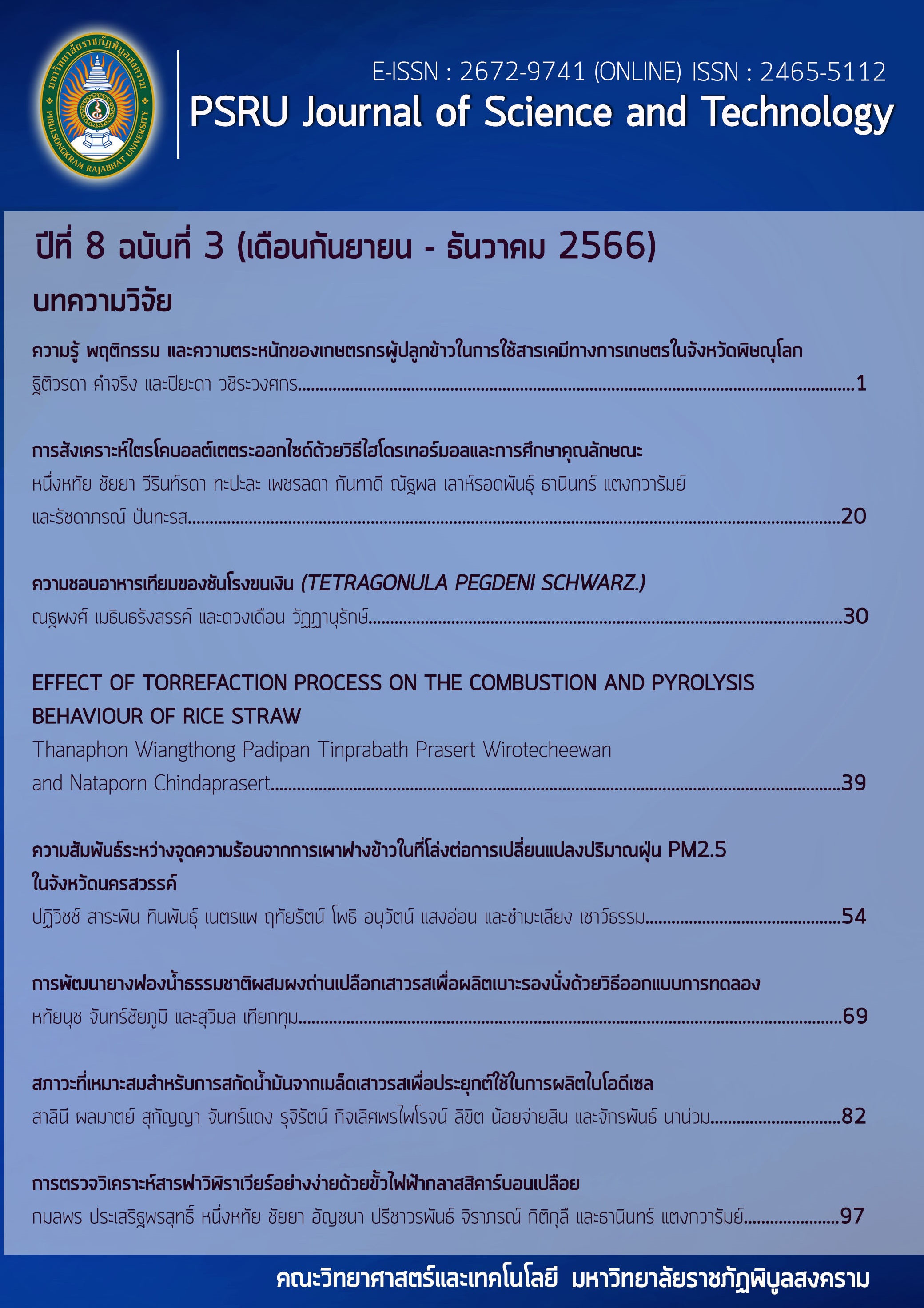EFFECT OF TORREFACTION PROCESS ON THE COMBUSTION AND PYROLYSIS BEHAVIOUR OF RICE STRAW
Keywords:
Torrefaction, Rice straw, Pyrolysis, Combustion, Thermogravimetric analysis (TGA)Abstract
Biomass is widely recognized as a renewable energy source that can be used as a substitute for fossil fuels. In order to comprehend and simulate combustion of biomass in large-scale furnaces and to effectively design and operate conversion systems, it is crucial to develop a comprehensive understanding of the pyrolysis characteristics and combustion kinetics. The objective of this study is to conduct a comparative analysis of the thermal properties and kinetic behaviour of raw rice straw and torrefied rice straw under both inert and oxidative atmospheres using thermogravimetric analyser. The results revealed that the lower temperature of initial combustion (Tic) for rice straw was found to be 249 °C, while Tic for torrefied rice straw was 252 °C. Tic serves as a critical parameter for ensuring the safe storage of both raw and torrefied rice straw. The Burnout temperature (Tb) values for both raw and torrefied rice straw fell within
the range of 468 °C to 470 °C, indicating that all samples achieved complete combustion at the same temperature. The results showed that the degree of thermal decomposition is higher for the torrefied rice straw, which suggested that the sample was less reactive than raw rice straw. The findings of this study can facilitate the design of combustion reactors and the determination of optimal operating conditions for such reactors.
References
Agar, D., & Wihersaari, M. (2012). Torrefaction technology for solid fuel production. GCB Bioenergy, 4(5), 475-478.
Broström, M., Nordin, A., Pommer, L., Branca, C., & Di Blasi, C. (2012). Influence of torrefaction on the devolatilization and oxidation kinetics of wood. Journal of Analytical and Applied Pyrolysis, 96, 100–109.
Cahyanti, M.N., Doddapaneni, T.R.K.C., & Kikas, T. (2020). Biomass torrefaction: An overview on process parameters, economic and environmental aspects and recent advancements. Bioresource Technology, 301, 122737.
Candelier, K., Dibdiakova, J., Volle, G., & Rousset, P. (2016). Study on chemical oxidation of heat treated lignocellulosic biomass under oxygen exposure by STA-DSC-FTIR analysis. Thermochimica Acta, 644, 33–42.
Cruz Ceballos, D.C., Hawboldt, K., & Hellleur, R. (2015). Effect of production conditions on self-heating propensity of torrefied sawmill residues. Fuel, 160, 227–237.
Di Blasi, C. (2008). Modeling chemical and physical processes of wood and biomass pyrolysis. Progress in Energy and Combustion Science, 34(1), 47–90.
Fadhil, H.A.M., Hassan, S., Aniza, N., Hassan, A., & Aris, S. (2014). Ignition and Burnout Temperature Study of Poultry Processing Dewatered Sludge (PPDS). Applied Mechanics and Materials, 695, 438–442.
Gani, A., & Naruse, I. (2007). Effect of cellulose and lignin content on pyrolysis and combustion characteristics for several types of biomass. Renewable Energy, 32(4), 649–661.
World Bioenergy Association, W.B. (2021). Global bioenergy statistics 2021, Retrieved February, 10, 2023, from https://www.worldbioenergy.org/uploads/211214%20WBA%20GBS%202021.pdf.
Kaur, R., Gera, P., Jha, M.K., & Bhaskar, T. (2018). Pyrolysis kinetics and thermodynamic parameters of castor (Ricinus communis) residue using thermogravimetric analysis. Bioresource Technology, 250, 422–428.
Li, B., Chen, G., Zhang, H., & Sheng, C. (2014). Development of non-isothermal TGA-DSC for kinetics analysis of low temperature coal oxidation prior to ignition. Fuel, 118, 385–391.
Liu, L., Pang, Y., Lv, D., Wang, K., & Wang, Y. (2021). Thermal and kinetic analyzing of pyrolysis and combustion of self-heating biomass particles. Process Safety and Environmental Protection, 151, 39–50.
Lu, J.J., & Chen, W.H. (2015). Investigation on the ignition and burnout temperatures of bamboo and sugarcane bagasse by thermogravimetric analysis. Applied Energy, 160(2015), 49–57.
Luo, Q., Liang, D., & Shen, H. (2016). Evaluation of self-heating and spontaneous combustion risk of biomass and fishmeal with thermal analysis (DSC-TG) and self-heating substances test experiments. Thermochimica Acta, 635, 1–7.
Prins, M.J., Ptasinski, K.J., & Janssen, F.J.J.G. (2006). Torrefaction of wood. Part 2. Analysis of products. Journal of Analytical and Applied Pyrolysis, 77(1), 35–40.
Ramírez, Á., García-Torrent, J., & Tascón, A. (2010). Experimental determination of self-heating and self-ignition risks associated with the dusts of agricultural materials commonly stored in silos. Journal of Hazardous Materials, 175(1–3), 920–927.
Rostam-Abadi, M., Debarr, J.A., & Chen, W.T. (1990). Combustion studies of coal derived solid fuels by thermogravimetric analysis. Thermochimica Acta, 166, 351–356.
Sedlmayer, I., Arshadi, M., Haslinger, W., Hofbauer, H., Larsson, I., Lönnermark, A., …,& Bauer-Emhofer, W. (2018). Determination of off-gassing and self-heating potential of wood pellets – Method comparison and correlation analysis. Fuel, 234, 894–903.
Vassilev, S.V., Vassileva, C.G., & Vassilev, V.S. (2015). Advantages and disadvantages of composition and properties of biomass in comparison with coal: An overview. Fuel, 158, 330–350.
Wiangthong, T., Tinprabath, P., Wirotecheewan, P., & Chindaprasert, N. (2023). Effect of torrefaction severity on the fuel properties of torrefied rice straw. PSRU Journal of Science and Technology, 8(1), 13–26.
Wigley, T., Yip, A.C.K., & Pang, S. (2016). Pretreating biomass via demineralisation and torrefaction to improve the quality of crude pyrolysis oil. Energy, 109, 481–494.
Worasuwannarak, N., Sonobe, T., & Tanthapanichakoon, W. (2007). Pyrolysis behaviors of rice straw, rice husk, and corncob by TG-MS technique. Journal of Analytical and Applied Pyrolysis, 78(2), 265–271.
Downloads
Published
Versions
- 2025-10-28 (3)
- 2024-05-29 (2)
- 2023-12-20 (1)
How to Cite
Issue
Section
License
Copyright (c) 2023 PSRU Journal of Science and Technology

This work is licensed under a Creative Commons Attribution-NonCommercial-NoDerivatives 4.0 International License.
กองบรรณาธิการขอสงวนสิทธิ์ในการปรับปรุงแก้ไขตัวอักษรและคำสะกดต่างๆ ที่ไม่ถูกต้อง และต้นฉบับที่ได้รับการตีพิมพ์ในวารสาร PSRU Journal of Science and Technology ถือเป็นกรรมสิทธิ์ของคณะวิทยาศาสตร์และเทคโนโลยี มหาวิทยาลัยราชภัฏพิบูลสงคราม และ
ผลการพิจารณาคัดเลือกบทความตีพิมพ์ในวารสารให้ถือมติของกองบรรณาธิการเป็นที่สิ้นสุด







